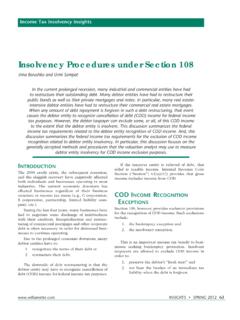Transcription of AN INTERNATIONAL COMPARISON OF …
1 corporate AFFAIRS DIVISION, DIRECTORATE FOR FINANCIAL AND ENTERPRISE AFFAIRS ORGANISATION FOR ECONOMIC CO-OPERATION AND DEVELOPMENT 2 RUE ANDR -PASCAL, PARIS 75116, FRANCE AN INTERNATIONAL COMPARISON OF INSOLVENCY LAWS by Wang Huaiyu Meeting held on 27-28 April 2006 This document reproduces a report by Mr. Wang Huaiyu written after the Fifth Forum for Asian Insolvency Reform (FAIR) which was held on 27-28 April 2006 in Beijing, China. It will form part of the forthcoming publication Legal & Institutional Reforms of Asian Insolvency Systems . CHAPTER TITLE 1 BOOK TITLE IN CAPITALS ISBN-92-64-XXXXX-X OECD 2006 AN INTERNATIONAL COMPARISON OF INSOLVENCY LAWS by Wang Huaiyu* Comparatively speaking, the criteria used for deeming an enterprise bankrupt and the priority of labour creditors are two core problems in insolvency law.
2 The former is the precondition for the execution of insolvency law. The latter influences the execution of insolvency law; it establishes creditors rights and interests, and develops an effective economic order. The Chinese Insolvency Law is about to be revised. The new one will be geared to INTERNATIONAL standards in accordance with conditions extant in China. This text summarises pertinent regulations in 42 different countries. 1) On bankruptcy criteria Bankruptcy criteria describe the conditions under which an enterprise can turn to bankruptcy procedures. When certain conditions are met, an enterprise can apply for voluntary bankruptcy, or it can be forced into a bankruptcy procedure under a creditor s application. We have roughly classified the regulations of 42 countries with respect to bankruptcy conditions.
3 They are as follows: a) The inability to pay off debts i) The inability to pay off expired debts is a bankruptcy condition in: Australia; Canada; Chile; Estonia; France; Germany; Hong Kong, China; Hungary; Indonesia; Italy (except for companies that can rapidly improve their economic condition); New Zealand; Scotland; Singapore; Slovakia; the US; Venezuela; and Viet Nam. * Enterprise Research Institute, Development Research Centre of the State Council. 2 CHAPTER TITLE BOOK TITLE IN CAPITALS ISBN-92-64-XXXXX-X OECD 2006 ii) Some limits or specific conditions are added to the inability to pay off debts as a basic bankruptcy condition. For example, Belgium, Bermuda, Colombia, England and Wales (the inability to offset its debts with its assets is one of the causes of the inability to pay off its debts), Malaysia, Romania, Russia, South Africa, Switzerland, and Thailand, (debts greater than 5% of gross debts).
4 Iii) The permanent inability to pay off debts. Not many countries have this as a condition for bankruptcy. Finland is an example. b) The inability to pay off its expired debts or the inability to offset its debts with assets. An enterprise can turn to a bankruptcy procedure provided it meets one of the situations. For example, Austria, the Czech Republic, Israel, Japan, Latvia, Mexico (the debtor s assets cannot offset more than 80% of its debt), Poland and other countries. c) The inability to pay off the expired debts and also the inability to offset its debts with its assets. For example, Norway and Spain. d) No specific bankruptcy condition is specified; the creditor can prove that the enterprise is bankrupt in any way. This kind of bankruptcy is not strictly limited.
5 It leaves judges wide room to decide whether a company qualifies for bankruptcy. This kind of regulation exists in Sweden. Some countries use the period of sustained losses, business stops or the attempt of management to flee the country etc. as conditions for bankruptcy. In Viet Nam, employees with three consecutive months of unpaid wages can apply for the bankruptcy of their employer. As a whole, most countries make the inability to pay off debts the basic condition for bankruptcy. 2) The relationship between employee, creditor, and secured creditor rights A debtor-secured creditor relationship usually exists between banks and enterprises. It is very important for enterprises to maintain their banking relationships as a source of financing. But, employees are necessary to actually run an enterprise.
6 So when an enterprise falls into bankruptcy, the question of how to deal with the interests of its two most important creditors becomes important. The following describes INTERNATIONAL approaches: CHAPTER TITLE 3 BOOK TITLE IN CAPITALS ISBN-92-64-XXXXX-X OECD 2006 a) Give the employees absolute priority protection, employee rights come prior to secured creditors rights. Countries with such regulations are Brazil (this section is being modified in a new law), Chile, Columbia, Indonesia (specified in the New Labour Law in 2003), and Mexico. b) Provide absolute priority to employee creditors with certain restrictions. For example, employee creditors meeting certain requirements have priority over secured creditors within a certain period. Countries using this approach are the Czech Republic (Secured creditor s can only can be repaid preferentially from 70% of the value of the security, the remaining 30% is to be added to the bankrupt s assets.
7 Employees are paid preferentially with 30% of the bankrupt s assets. Unpaid employees and secured creditors are repaid as common creditors from the remaining 70%), Russia (employee creditors come prior to fixed security after it expires), Spain (within the last 30 days). c) Secured creditor s come prior to employee creditors while employee creditors come prior to floating security creditors. Examples are Australia; Bermuda; England; Hong Kong, China; Israel; Romania; Scotland; Singapore; Slovakia; and Wales. d) All secured creditors rights are prior to employee creditors rights while employee creditor rights are prior to common creditors rights. See Austria, Canada, Hungary, Japan, Malaysia, Norway, South Africa, Sweden, Switzerland, Thailand, Venezuela, Viet Nam, the US, and so on.
8 Among the above, generally speaking, there are certain restrictions on employee creditors rights in items c) and d), including restrictions on time and amount. e) Employee creditors do not enjoy any priority. They are repaid together with common creditors. Estonia, Germany and other countries have such regulations. We can see from the above that countries have different regulations on the priority of labour and secured creditors. The INTERNATIONAL Labour Organization put forward its Protecting Labour Creditor s Rights (Enterprise Bankruptcy) Convention in 1992. The convention came into effect in 1995. It stipulates that employee creditors rights shall be protected preferentially, but the relationship between it and secured creditor s rights are to be determined by each country according to their own national circumstances.
9 Nor does the EU Convention on Insolvency Proceedings, which came into effect on 31 May 2002, directly address the relationship between labour and 4 CHAPTER TITLE BOOK TITLE IN CAPITALS ISBN-92-64-XXXXX-X OECD 2006 secured creditors rights. It leaves it to each country to decide. The relationship between these two kinds of creditor s rights is thus entirely determined by each country s domestic law. It has nothing to do with whether a country has a market economy or not. Most countries do not equate labour creditor rights with common creditors rights. Instead they always confer a certain priority. This is because of the importance of labour in market development. At the same time, labour is in a vulnerable position in the employment relationship, since it is unable to ask employers to provide guarantees for payment when signing employment contracts.
10 This puts labour in an unfavourable situation compared with other creditors. In order to establish and perfect an efficient labour market and to defend principles of fairness and equitable treatment, most countries give labour creditors certain priority rights. But this kind of priority differs depending on the country. Some countries specify that labour comes before most other creditors (including secured creditors); some countries specify that labour creditors come before most other creditors (except secured creditors); and some countries put them on a level with common creditors. Regardless of the priority, labour creditor rights have certain restrictions on time and amount in most countries (refer to Table 3). Such restrictions can enhance labour s realisation of market risk and make talent move to better enterprises.















